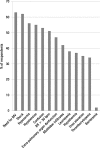Management of severe community-acquired pneumonia in Brazil: a secondary analysis of an international survey
- PMID: 25909314
- PMCID: PMC4396898
- DOI: 10.5935/0103-507X.20150010
Management of severe community-acquired pneumonia in Brazil: a secondary analysis of an international survey
Abstract
Objective: This study aimed to evaluate Brazilian physicians' perceptions regarding the diagnosis, severity assessment, treatment and risk stratification of severe community-acquired pneumonia patients and to compare those perceptions to current guidelines.
Methods: We conducted a cross-sectional international anonymous survey among a convenience sample of critical care, pulmonary, emergency and internal medicine physicians from Brazil between October and December 2008. The electronic survey evaluated physicians' attitudes towards the diagnosis, risk assessment and therapeutic interventions for patients with severe community-acquired pneumonia.
Results: A total of 253 physicians responded to the survey, with 66% from Southeast Brazil. The majority (60%) of the responding physicians had > 10 years of medical experience. The risk assessment of severe community-acquired pneumonia was very heterogeneous, with clinical evaluation as the most frequent approach. Although blood cultures were recognized as exhibiting a poor diagnostic performance, these cultures were performed by 75% of respondents. In contrast, the presence of urinary pneumococcal and Legionella antigens was evaluated by less than 1/3 of physicians. The vast majority of physicians (95%) prescribe antibiotics according to a guideline, with the combination of a 3rd/4th generation cephalosporin plus a macrolide as the most frequent choice.
Conclusion: This Brazilian survey identified an important gap between guidelines and clinical practice and recommends the institution of educational programs that implement evidence-based strategies for the management of severe community-acquired pneumonia.
Objetivo: Avaliar a percepção dos médicos brasileiros quanto ao diagnóstico, à avaliação de gravidade, ao tratamento e à estratificação de risco em pacientes com pneumonia grave adquirida na comunidade, e compará-la com as diretrizes atuais.
Métodos: Estudo transversal realizado por meio da aplicação de um questionário anônimo a uma amostra de médicos brasileiros especialistas em cuidados intensivos, medicina de emergência, medicina interna e pneumologia. Entre outubro e dezembro de 2008, foram avaliadas as atitudes dos médicos no diagnóstico, a avaliação de risco e as intervenções terapêuticas para pacientes com pneumonia grave adquirida na comunidade.
Resultados: Responderam ao questionário 253 médicos, sendo 66% da Região Sudeste do Brasil. A maioria (60%) dos médicos que responderam tinha mais de 10 anos de experiência. Verificou-se que a avaliação de risco de pneumonia grave adquirida na comunidade foi muito heterogênea, sendo a avaliação clínica a forma de avaliação de risco mais frequente. As hemoculturas foram habitualmente realizadas por 75% dos médicos, entretanto, foi reconhecido seu fraco desempenho diagnóstico. Por outro lado, a pesquisa de antígenos urinários de Pneumococo e Legionella foi solicitada por menos de um terço dos médicos. A maioria (95%) prescreveu antibióticos de acordo com as diretrizes. A combinação de uma cefalosporina de terceira ou quarta geração com um macrolídeo foi a escolha mais comum.
Conclusão: Este inquérito brasileiro demonstrou diferenças entre as diretrizes publicadas e a prática clínica. Isso leva à necessidade de se desenvolverem programas educacionais e de adoção de protocolos para implementar estratégias baseadas em evidências no manejo da pneumonia grave adquirida na comunidade.
Conflict of interest statement
Figures


Similar articles
-
Management of severe community-acquired pneumonia: a survey on the attitudes of 468 physicians in Iberia and South America.J Crit Care. 2014 Oct;29(5):743-7. doi: 10.1016/j.jcrc.2014.05.019. Epub 2014 May 29. J Crit Care. 2014. PMID: 24973102
-
Blind Spots of Traditional Microbiological Tests for Severe Community-Acquired Pneumonia in Adults and Availability of Nonculture Techniques: A Nationwide Survey of Physicians in China.J Infect Dis. 2020 Mar 16;221(Suppl 2):S198-S205. doi: 10.1093/infdis/jiz636. J Infect Dis. 2020. PMID: 32176798
-
An audit of inpatient management of community-acquired pneumonia in Oman: a comparison with regional clinical guidelines.J Infect Public Health. 2012 Jun;5(3):250-6. doi: 10.1016/j.jiph.2012.03.002. Epub 2012 Apr 20. J Infect Public Health. 2012. PMID: 22632599
-
CAP management guidelines.Nurse Pract. 2006 Jan;31(1):43-7, 49-53; quiz 53-5. Nurse Pract. 2006. PMID: 16395058 Review. No abstract available.
-
Clinical practice. Management of community-acquired pneumonia.N Engl J Med. 2002 Dec 19;347(25):2039-45. doi: 10.1056/NEJMcp020499. N Engl J Med. 2002. PMID: 12490686 Review. No abstract available.
Cited by
-
Recommendations for mechanical ventilation of critically ill children from the Paediatric Mechanical Ventilation Consensus Conference (PEMVECC).Intensive Care Med. 2017 Dec;43(12):1764-1780. doi: 10.1007/s00134-017-4920-z. Epub 2017 Sep 22. Intensive Care Med. 2017. PMID: 28936698 Free PMC article.
-
Clinical, epidemiological, and etiological profile of inpatients with community-acquired pneumonia in a public hospital in the interior of Brazil.J Bras Pneumol. 2018 Jul-Aug;44(4):261-266. doi: 10.1590/S1806-37562017000000434. J Bras Pneumol. 2018. PMID: 30328925 Free PMC article.
-
Charlson Comorbidity Index and other predictors of in-hospital mortality among adults with community-acquired pneumonia.J Bras Pneumol. 2021 Feb 24;47(1):e20200257. doi: 10.36416/1806-3756/e20200257. eCollection 2021. J Bras Pneumol. 2021. PMID: 33656092 Free PMC article.
References
-
- Brown SM, Jones BE, Jephson AR, Dean NC, Infectious Disease Society of America/American Thoracic Society 2007 Validation of the Infectious Disease Society of America/American Thoracic Society 2007 guidelines for severe community-acquired pneumonia. Crit Care Med. 2009;37(12):3010–3016. - PMC - PubMed
-
- Silva E, Dalfior L, Junior, Fernandes HD, Moreno R, Vincent JL. Prevalence and outcomes of infections in Brazilian ICUs: a subanalysis of EPIC II study. Rev Bras Ter Intensiva. 2012;24(2):143–150. - PubMed
-
- Bozza FA, Salluh JI. An urban perspective on sepsis in developing countries. Lancet Infect Dis. 2010;10(5):290–291. - PubMed
-
- Ewig S, Ruiz M, Mensa J, Marcos MA, Martinez JA, Arancibia F, et al. Severe community-acquired pneumonia. Assessment of severity criteria. Am J Respir Crit Care Med. 1998;158(4):1102–1108. - PubMed
Publication types
MeSH terms
Substances
LinkOut - more resources
Full Text Sources
Medical
Miscellaneous

